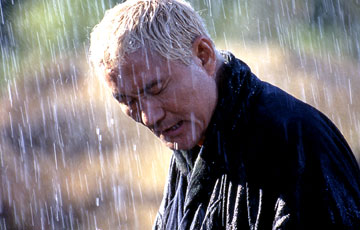

The name Zatoichi has little meaning in the United States. In Japan, it is the title character of a wildly popular series of movies that spanned 26 films and 27 years (all played by Shintaro Katsu - take that James Bond). Zatoichi is a master swordsman who wanders from town to town in feudal Japan. He is blind, and wanders from town to town, and the stories play out much like a western. This new version of Zatoichi is a re-imagining by director Takeshi Kitano, who places his indelible trademarks of wry humor and sometimes grotesque violence onto the film. After watching it, one cannot imagine many other directors capable of remaking the original. At no point is anybody surprised at what is happening on screen or where the story is going, but Kitano is having so much fun with the film that nobody cares.
Kitano, (Brother, Dolls), who acts under the moniker of "Beat," is Zatoichi. He's bleached blonde, and as taciturn as all of Kitano's characters seem to be. His latest wanderings take him to a town in the throes of gang war. Rival gangs are battling for supremacy of the town, and the townsfolk are caught in the middle. Some other strangers show up at the same time. Gennosuke Hattori (Tadanobu Asano, Last Life in the Universe, My Grandpa) is a ronin looking for work, who agrees to be the bodyguard of one of the gang's leaders. Two geishas (Yuuko Daike, Dolls, Ju-On 2, and Daigoro Tachibana) are in town seeking bloody vengeance on the people that killed their parents years ago. They subsist by luring men to them and them robbing them.
And like many westerns, the story is just not that important. Kitano, who also wrote the script (adapted from the novels of Kan Shimozawa) is more interested in the style that he and his characters do things rather than what eventually happens. As expected, the various plotlines converge into one. Smaller gangs will slowly die off and eventually Zatoichi and Hattori will have some nasty showdown. Nobody expects anything from this frail, blind masseur, but everybody soon knows better than to underestimate them. There are a lot of characters, especially bad guys, and it is easy to get a little lost at the beginning, but things quickly coalesce as Kitano finds his groove.
The most entertaining aspect is Kitano. Like most of this other roles, Zatoichi is terse, but when he speaks, people listen. This just reinforces the artificial fragility of the masseuse identity. He moves slowly, looking as if he is wracked with pain. But his cane hides a sword, and he strikes with deadly accuracy. Kitano is known for using extreme violence in his movies, with enough blood and guts to easily shock people. Here, it comes in the form of fountains of CGI blood, spurting from stabbings and sword wounds. The blood occupies this weird nether region of looking somewhat real yet fake at the same time. Kitano is also a very funny guy, and throws out some deadpan humor at the strangest times. On a more ambitious level, he even incorporates the sounds of farmers in a field into a soundtrack (which works) and includes a song and dance number at the end (which doesn't). Fans of both Kitano and Zatoichi can come away pleased, since Kitano has successfully left his own mark up on the franchise and moved it into the present while keeping the spirit of the original films. Here's hoping for sequels that are just as good.